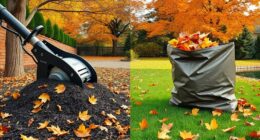To prepare your home for winter, start by cleaning gutters, trimming trees, and covering outdoor furniture. Schedule a furnace inspection, replace filters, and check for duct blockages to stay warm efficiently. Seal gaps around windows and doors, inspect your roof and foundation, and insulate pipes to prevent freezing. Staying proactive now helps avoid costly repairs and keeps your home safe and cozy all season long—more tips await to make your winter ready.
Key Takeaways
- Clear leaves and prune branches to prevent gutter clogs and hazards.
- Cover outdoor furniture and store garden tools to protect from winter weather.
- Schedule a professional furnace inspection and replace filters for efficiency.
- Seal gaps around windows and doors, and clean gutters to ensure proper drainage.
- Inspect roof, foundation, and insulation to prevent winter damage and drafts.

As the leaves start to change color and temperatures drop, it’s the perfect time to prepare your home for the upcoming winter months. One of your first priorities should be tackling some seasonal yardwork. Clearing away fallen leaves, pruning dead branches, and trimming overgrown shrubs not only makes your yard look tidy but also prevents potential hazards. Leaves left to accumulate can clog gutters and create ice dams, which can lead to water damage inside your home. Raking regularly helps keep your yard manageable and reduces the risk of pests seeking shelter in decaying foliage. Additionally, you should consider aerating your lawn to promote healthy grass growth come spring. Covering or storing outdoor furniture and garden tools will protect them from winter weather, extending their lifespan. These small steps make a significant difference in maintaining your yard’s health and appearance during the colder months.
Alongside yardwork, scheduling a furnace inspection is essential. Your furnace will be working overtime to keep your home warm and comfortable, so guaranteeing it’s operating efficiently and safely is necessary. A professional inspection can identify issues like clogged filters, faulty thermostats, or worn-out components that might cause a breakdown when you need heat the most. During the inspection, technicians will clean and tune the system, helping it run more efficiently and potentially lowering energy costs. If your furnace is older or showing signs of trouble, now’s the time to consider repairs or even a replacement before the coldest weather hits. Regular maintenance not only extends the lifespan of your heating system but also ensures it performs reliably throughout winter. Don’t forget to replace filters and check vents for blockages—these simple steps improve airflow and efficiency. Additionally, understanding fetal development stages can help you better prepare for the physical changes during pregnancy and ensure your health and comfort.
While you’re at it, take a walk around your property to inspect your home’s exterior. Seal any gaps or cracks around windows and doors to prevent drafts, which can make your heating system work harder. Check your gutters and downspouts again; clearing debris ensures proper drainage and prevents ice buildup that could damage your roof or foundation. Don’t ignore your pipes either—insulating exposed plumbing can prevent freezing and bursting during cold snaps. These preparations are straightforward but indispensable for avoiding costly repairs. By staying proactive with seasonal yardwork and a thorough furnace inspection, you’re setting yourself up for a cozy, trouble-free winter. Taking these steps now keeps your home safer, more energy-efficient, and ready to face the season’s challenges.
Frequently Asked Questions
When Is the Best Time to Schedule a Fall Home Inspection?
You should schedule your fall home inspection in early autumn, ideally September or October. This timing allows you to address seasonal pest control issues and outdoor gutter cleaning before winter arrives. By inspecting your home now, you can spot and fix any vulnerabilities, preventing pest invasions and water damage. Early fall is perfect for prepping your home’s exterior and interior, ensuring you’re ready for the colder months ahead.
How Often Should I Clean My Chimney in the Fall?
You should clean your chimney at least once a year, ideally before the heating season begins. Ironically, many only think about chimney cleaning after a problem arises. Don’t wait for smoke to billow or odors to appear—schedule a chimney inspection and cleaning now. Regular chimney cleaning keeps your fireplace safe and efficient, preventing dangerous creosote buildup. Trust me, a proactive approach saves you from costly repairs later.
What Are the Signs My Roof Needs Repair Before Winter?
You should inspect your roof for signs of damage or shingle deterioration before winter. Look for missing, cracked, or curling shingles, as these indicate potential leaks. Check for roof damage like sagging or water stains on your ceilings, which suggest underlying issues. Missing granules on shingles or moss growth are also warning signs. Addressing these problems early helps prevent costly repairs and keeps your home protected during the colder months.
How Can I Prevent Cold Drafts in My Home?
You might find yourself shivering unexpectedly, but you can prevent cold drafts by draft proofing your home and upgrading insulation. Seal gaps around windows and doors with weatherstripping or caulk, and consider adding insulation to attics and walls. These simple steps create a cozy atmosphere, making your home warmer and more energy-efficient. Taking action now guarantees you stay comfortable as temperatures drop, turning chilly surprises into a thing of the past.
Are There Eco-Friendly Fall Maintenance Tips I Should Consider?
Yes, you should consider eco-friendly fall maintenance tips like using sustainable cleaning products to reduce chemical runoff and opting for renewable energy solutions such as solar panels. Regularly clean and insulate your home to improve energy efficiency, and avoid harsh chemicals that harm the environment. These steps help lower your carbon footprint while maintaining a cozy, sustainable home through the colder months.
Conclusion
Completing your fall home maintenance checklist now can save you money and prevent costly repairs later. Did you know that properly maintaining your home can reduce energy bills by up to 25%? Staying proactive guarantees your home stays safe and cozy through the season. Don’t wait—tackle these tasks today, so you can enjoy a warm, worry-free fall and winter ahead. Your efforts now will pay off in comfort and savings all season long.










